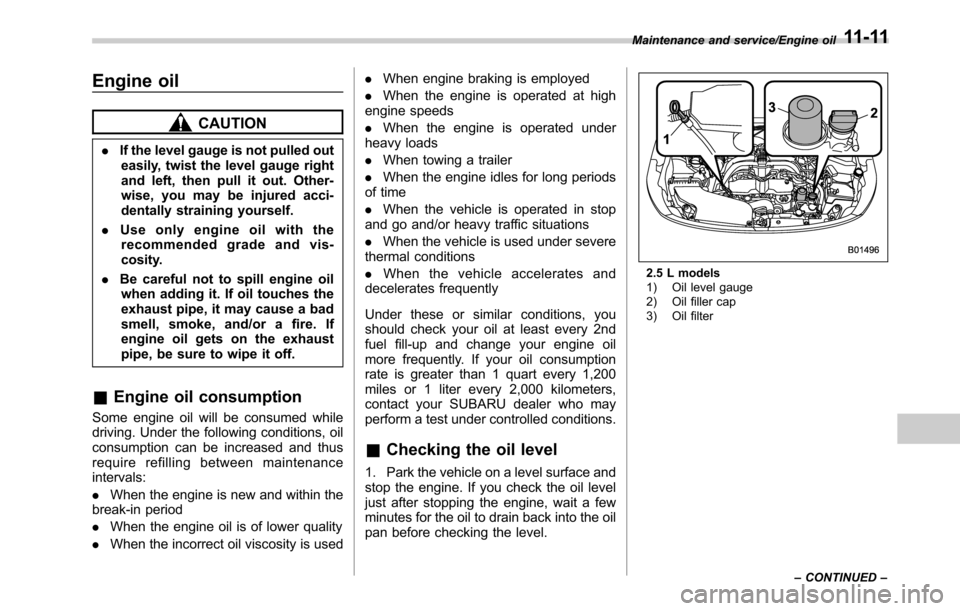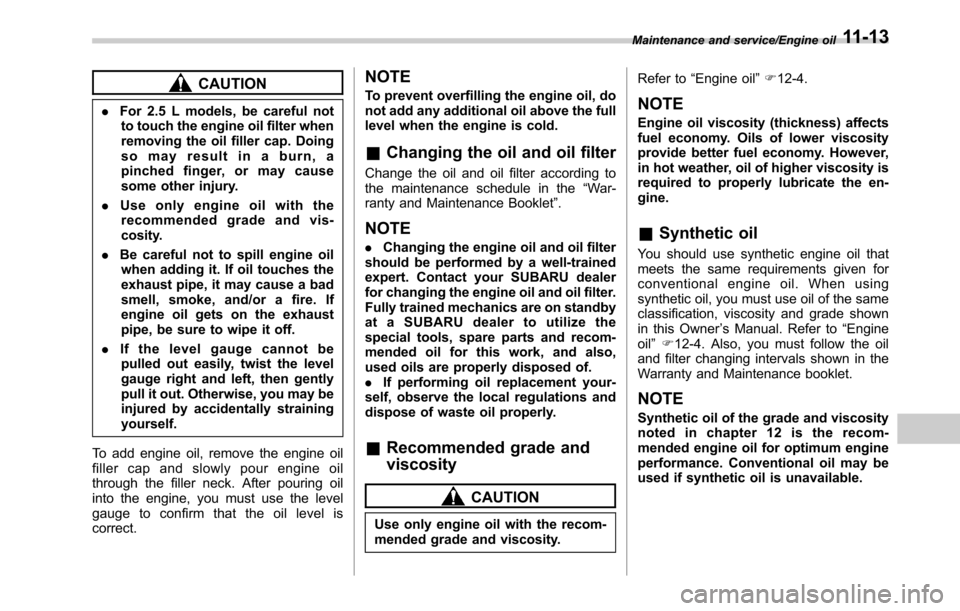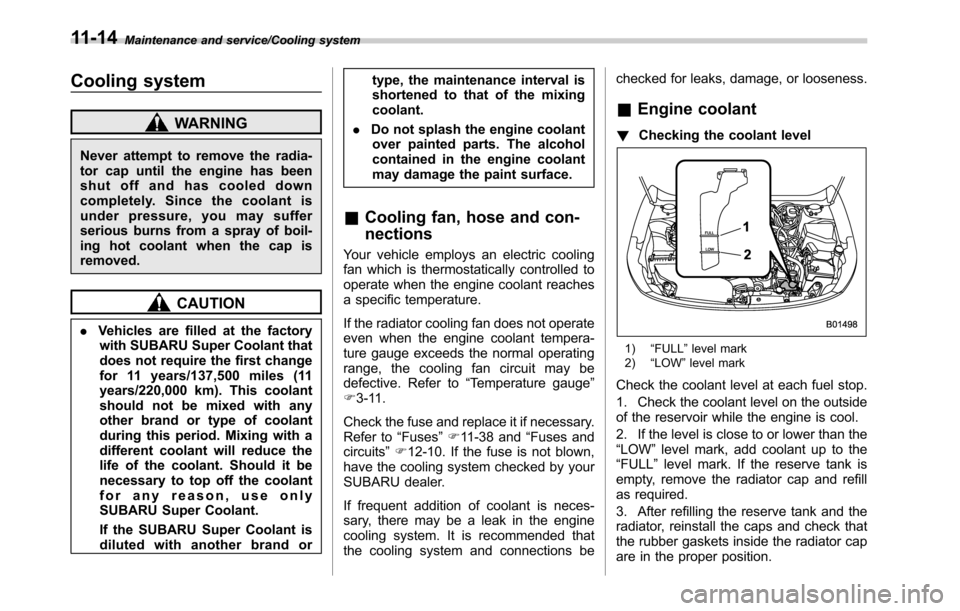Page 477 of 572
Engine compartment overview
&2.5 L models
1) Brake fluid reservoir/Clutch fluid reservoir
(MT) (page 11-19)
2) Fuse box (page 11-38)
3) Windshield washer tank (page 11-32)
4) Battery (page 11-37)
5) Engine oil filler cap (page 11-11)
6) Engine coolant reservoir (page 11-14)
7) Radiator cap (page 11-14)
8) Engine oil filter (page 11-13)
9) Engine oil level gauge (page 11-11)
10) Air cleaner case (page 11-15) Maintenance and service/Engine compartment overview
–CONTINUED–
11-9
Page 478 of 572
Maintenance and service/Engine compartment overview
&3.6 L models1) Brake fluid reservoir (page 11-19)
2) Fuse box (page 11-38)
3) Windshield washer tank (page 11-32)
4) Battery (page 11-37)
5) Engine oil filler cap (page 11-11)
6) Engine coolant reservoir (page 11-14)
7) Radiator cap (page 11-14)
8) Engine oil level gauge (page 11-11)
9) Air cleaner case (page 11-15)
11-10
Page 479 of 572

Engine oil
CAUTION
.If the level gauge is not pulled out
easily, twist the level gauge right
and left, then pull it out. Other-
wise, you may be injured acci-
dentally straining yourself.
.Use only engine oil with the
recommended grade and vis-
cosity.
.Be careful not to spill engine oil
when adding it. If oil touches the
exhaust pipe, it may cause a bad
smell, smoke, and/or a fire. If
engine oil gets on the exhaust
pipe, be sure to wipe it off.
&Engine oil consumption
Some engine oil will be consumed while
driving. Under the following conditions, oil
consumption can be increased and thus
require refilling between maintenance
intervals:
.When the engine is new and within the
break-in period
.When the engine oil is of lower quality
.When the incorrect oil viscosity is used.When engine braking is employed
.When the engine is operated at high
engine speeds
.When the engine is operated under
heavy loads
.When towing a trailer
.When the engine idles for long periods
of time
.When the vehicle is operated in stop
and go and/or heavy traffic situations
.When the vehicle is used under severe
thermal conditions
.When the vehicle accelerates and
decelerates frequently
Under these or similar conditions, you
should check your oil at least every 2nd
fuel fill-up and change your engine oil
more frequently. If your oil consumption
rate is greater than 1 quart every 1,200
miles or 1 liter every 2,000 kilometers,
contact your SUBARU dealer who may
perform a test under controlled conditions.
&Checking the oil level
1. Park the vehicle on a level surface and
stop the engine. If you check the oil level
just after stopping the engine, wait a few
minutes for the oil to drain back into the oil
pan before checking the level.
2.5 L models
1) Oil level gauge
2) Oil filler cap
3) Oil filter Maintenance and service/Engine oil
–CONTINUED–
11-11
Page 480 of 572
Maintenance and service/Engine oil
3.6 L models
1) Oil level gauge
2) Oil filler cap
2. Pull out the level gauge, wipe it clean,
and insert it again.
3. Be sure the level gauge is correctly
inserted until it stops.
2.5 L models
1) Full level
2) Low level
3) Approximately 1.1 US qt (1.0 liter, 0.9
Imp qt) from low level to full level3.6 L models
1) Full level
2) Low level
3) Approximately 1.1 US qt (1.0 liter, 0.9
Imp qt) from low level to full level
4. Pull out the oil level gauge again.
5.2.5 L models:
Check the oil levels on both sides of the
level gauge. The engine oil level must be
judged by the lowest of the two levels. If
the oil level is below the low level mark,
add oil so that the full level is reached.
3.6 L models:
Check the oil level on the gauge. If the oil
level is below the low level mark, add oil
so that the full level is reached.
11-12
Page 481 of 572

CAUTION
.For 2.5 L models, be careful not
to touch the engine oil filter when
removing the oil filler cap. Doing
so may result in a burn, a
pinched finger, or may cause
some other injury.
.Use only engine oil with the
recommended grade and vis-
cosity.
.Be careful not to spill engine oil
when adding it. If oil touches the
exhaust pipe, it may cause a bad
smell, smoke, and/or a fire. If
engine oil gets on the exhaust
pipe, be sure to wipe it off.
.If the level gauge cannot be
pulled out easily, twist the level
gauge right and left, then gently
pull it out. Otherwise, you may be
injured by accidentally straining
yourself.
To add engine oil, remove the engine oil
filler cap and slowly pour engine oil
through the filler neck. After pouring oil
into the engine, you must use the level
gauge to confirm that the oil level is
correct.
NOTE
To prevent overfilling the engine oil, do
not add any additional oil above the full
level when the engine is cold.
&Changing the oil and oil filter
Change the oil and oil filter according to
the maintenance schedule in the“War-
ranty and Maintenance Booklet”.
NOTE
.Changing the engine oil and oil filter
should be performed by a well-trained
expert. Contact your SUBARU dealer
for changing the engine oil and oil filter.
Fully trained mechanics are on standby
at a SUBARU dealer to utilize the
special tools, spare parts and recom-
mended oil for this work, and also,
used oils are properly disposed of.
.If performing oil replacement your-
self, observe the local regulations and
dispose of waste oil properly.
&Recommended grade and
viscosity
CAUTION
Use only engine oil with the recom-
mended grade and viscosity.Refer to“Engine oil”F12-4.
NOTE
Engine oil viscosity (thickness) affects
fuel economy. Oils of lower viscosity
provide better fuel economy. However,
in hot weather, oil of higher viscosity is
required to properly lubricate the en-
gine.
&Synthetic oil
You should use synthetic engine oil that
meets the same requirements given for
conventional engine oil. When using
synthetic oil, you must use oil of the same
classification, viscosity and grade shown
in this Owner’s Manual. Refer to“Engine
oil”F12-4. Also, you must follow the oil
and filter changing intervals shown in the
Warranty and Maintenance booklet.
NOTE
Synthetic oil of the grade and viscosity
noted in chapter 12 is the recom-
mended engine oil for optimum engine
performance. Conventional oil may be
used if synthetic oil is unavailable.
Maintenance and service/Engine oil11-13
Page 482 of 572

Maintenance and service/Cooling system
Cooling system
WARNING
Never attempt to remove the radia-
tor cap until the engine has been
shut off and has cooled down
completely. Since the coolant is
under pressure, you may suffer
serious burns from a spray of boil-
ing hot coolant when the cap is
removed.
CAUTION
.Vehicles are filled at the factory
with SUBARU Super Coolant that
does not require the first change
for 11 years/137,500 miles (11
years/220,000 km). This coolant
should not be mixed with any
other brand or type of coolant
during this period. Mixing with a
different coolant will reduce the
life of the coolant. Should it be
necessary to top off the coolant
for any reason, use only
SUBARU Super Coolant.
If the SUBARU Super Coolant is
diluted with another brand ortype, the maintenance interval is
shortened to that of the mixing
coolant.
.Do not splash the engine coolant
over painted parts. The alcohol
contained in the engine coolant
may damage the paint surface.
&Cooling fan, hose and con-
nections
Your vehicle employs an electric cooling
fan which is thermostatically controlled to
operate when the engine coolant reaches
a specific temperature.
If the radiator cooling fan does not operate
even when the engine coolant tempera-
ture gauge exceeds the normal operating
range, the cooling fan circuit may be
defective. Refer to“Temperature gauge”
F3-11.
Check the fuse and replace it if necessary.
Refer to“Fuses”F11-38 and“Fuses and
circuits”F12-10. If the fuse is not blown,
have the cooling system checked by your
SUBARU dealer.
If frequent addition of coolant is neces-
sary, there may be a leak in the engine
cooling system. It is recommended that
the cooling system and connections bechecked for leaks, damage, or looseness.
&Engine coolant
!Checking the coolant level
1)“FULL”level mark
2)“LOW”level mark
Check the coolant level at each fuel stop.
1. Check the coolant level on the outside
of the reservoir while the engine is cool.
2. If the level is close to or lower than the
“LOW”level mark, add coolant up to the
“FULL”level mark. If the reserve tank is
empty, remove the radiator cap and refill
as required.
3. After refilling the reserve tank and the
radiator, reinstall the caps and check that
the rubber gaskets inside the radiator cap
are in the proper position.
11-14
Page 484 of 572
Maintenance and service/Air cleaner element
2. Open the air cleaner case.
3. Remove the air cleaner element.
CAUTION
If the inside of the air cleaner case is
extremely soiled (for example, by
sand), contact a SUBARU dealer
and have the air cleaner case
cleaned.
4. If you find large foreign objects such
as leaves inside the air cleaner case,
remove the foreign objects.
5. Install a new air cleaner element in the
way the longitudinal side and the trans-
verse side face as shown in the illustra-
tion.
6. To install the air cleaner case (rear),
insert the three projections on the air
cleaner case (rear) into the slits on the
air cleaner case (front).
7. Install in the reverse order of removal.
11-16
Page 485 of 572
!3.6 L models
1) Clips
1. Unsnap the two clips holding the air
cleaner case (rear).
2. Open the air cleaner case and removethe air cleaner element.
CAUTION
If the inside of the air cleaner case is
extremely soiled (for example, by
sand), contact a SUBARU dealer
and have the air cleaner case
cleaned.
3. If you find large foreign objects such
as leaves inside the air cleaner case,
remove the foreign objects.
4. Install a new air cleaner element in the
way the longitudinal side and the trans-
verse side face as shown in the illustra-
tion.
5. To install the air cleaner case (rear),
insert the three projections on the air
cleaner case (rear) into the slits on the
air cleaner case (front).
6. Install the removed parts in the reverse
order of removal.
Maintenance and service/Air cleaner element11-17